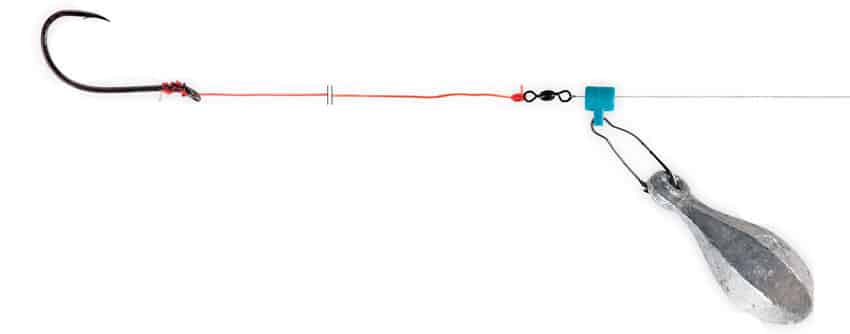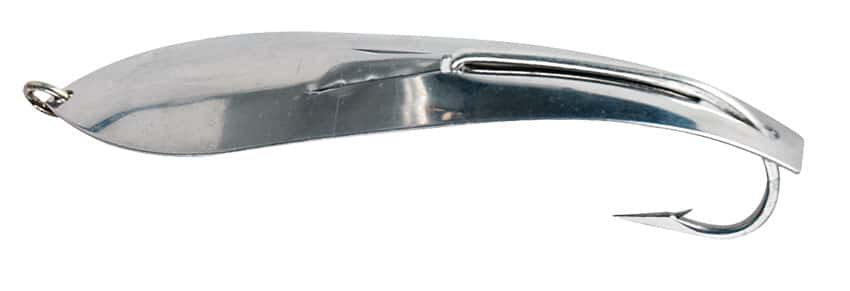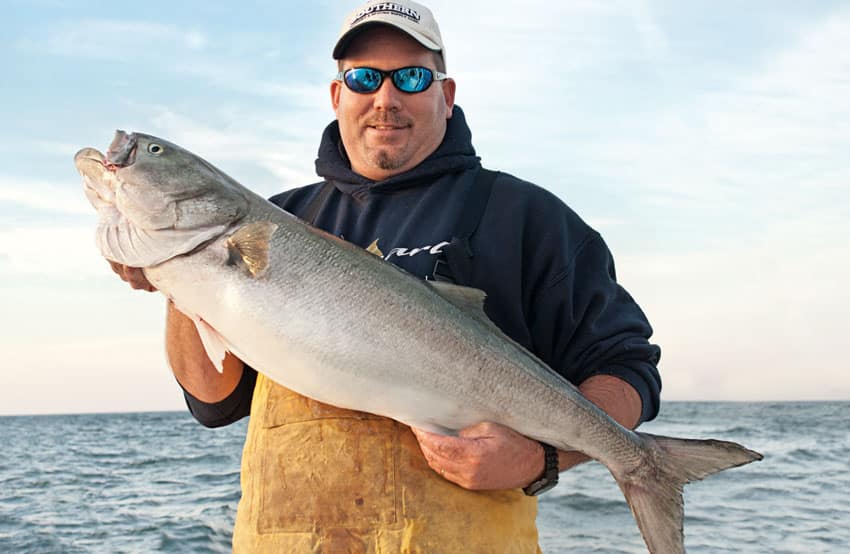
It was a sad story. Typical blues lyrics. My first true love had left me. Here one day and gone the next.
When I was a kid coming up in the waters off Lower Delaware, my first tangle with big fish was trolling for chopper bluefish with my dad. We would pull Hoochie Trolls and Rag Mops and catch 10- to 15-pound slammers one after another. I was so in love that my dad would have to wait until I fell asleep to get the gimbal belt off of me.
And what’s not to love? Big bluefish, called choppers, are an arm’s length of taut muscle and bad attitude.
In those days, bluefish were prolific.
Then the fish disappeared.
For 25 years, I rarely saw a big bluefish. That is, until a few years ago, when the blues came back.
Once again, anglers are encountering choppers from the surf to the 100-fathom curve. Without any love lost — my old flame reignited — I have the blues again.
Blue Mood
As soon as I heard reports of giant bluefish on the inshore wrecks off Virginia Beach, Virginia, I went head over heels.
Within a few days of the first reports, my buddies and I were heading toward Triangle Reef, 30 miles off Rudee Inlet, aboard Ken Neill’s 30-foot Albemarle, Healthy Grin.
It was late October, and the water was cold and gray, but a steady blow and four-foot seas couldn’t keep us from this date.
When we arrived on the scene, the bite was already on. A couple of charter boats were crisscrossing the artificial reef, which consists of a half-dozen scuttled ships scattered over several square miles.
Neill slowed the boat to 5 knots, and the rest of the crew went to work setting 20-pound outfits spooled with 25-pound-test. Neill navigated the ship like a pinball, bouncing it among the wrecks.
When the first few passes didn’t produce a fish, Neill began experimenting. The next turn across the wreck was faster. Still no bites.
Then we went slower, creeping over the structure, the rod tips bouncing as the spoons and plugs swayed back and forth in the water. Boom!
One of the rod tips dipped, and one of the anglers jumped on it. Neill continued to troll until two more rods bent double.
Three anglers each worked in a big blue, but even on heavy tackle, the fish were no pushovers, taking drag and pulling their adversaries around the cockpit.
When we saw the size of the fish, I put away the net and grabbed the gaff; this was a bigger class of bluefish.
Several of the blues weighed over 16 pounds — big enough for trophy citations from the Virginia Game Fish Tournament.
The super-slow troll was the ticket to fooling these monsters, so Neill put the boat into a turn and headed back to the wreck.
Each pass produced a handful of monster bluefish. After each of us had scored a citation blue, we decided to put away the trolling gear in favor of casting tackle.
Blue-Light Special
As Neill pulled the boat over the wreck, each of the anglers produced a medium-action conventional or spinning rod spooled with 50-pound PowerPro. Half of the crew went for the live croaker that Neill had stored in the livewells, and the other half grabbed artificial spoons and jigs.
It was obvious that this was going to get real ugly real fast.
My rod was rigged to drop a jig. I chose a 4-ounce Hopkins spoon. I figured the metal lure would help protect my line from a bluefish’s gnarly mouth. I chose the model with a single hook; considering blues’ propensity for violence, hooking up isn’t usually a problem. Also, a single hook makes it easier to set a bluefish free with a simple T-handle dehooker.
On the other side of the boat, the live-bait contingent was using similar tackle that was rigged with a fish-finder slide.
Since the blues were acting a little finicky, the guys’ first drops were not met with immediate success. To slow the presentation, Neill’s crew uses a trick. Instead of dropping the sinker and bait straight to the bottom, they hold the bait at the boat, take the reel out of gear and drop the sliding sinker to the wreck 120 feet below.
Once the weight reaches the bottom, they release the baitfish and then slowly turn the reel handle to retrieve line and guide the bait toward the bottom.
Very sneaky.
The trick worked, and the blues responded. One after another, the live baits started to hook fish.
Taking advantage of the feeding frenzy, I dropped my spoon into the water, careful to clear the other anglers’ lines, and waited for it to hit bottom. After letting it bounce a few times off the wreck (the single hook also helps it not get stuck in structure), I started to jig the spoon back to the surface by alternating between cranking the handle and jerking the rod tip.
After a couple of turns, a big blue attacked my spoon. As I jigged upward, the fish pulled down, nearly ripping the rod out of my hands. At first the fish didn’t realize it was hooked. I could feel it thrashing 100 feet below. When I applied pressure, the blue took notice, peeling off line and heading into the wreck. I pulled every trick to apply more pressure — pinching the line, raising the rod tip high, even lightly thumbing the spool. Nothing would stop the blue until it reached the jagged wreck on the bottom.
I winced as the braided line transmitted every head shake, the butt of the rod kicking me in the gut over and over again — I could feel even the sharp edges of the wreck rubbing the line.
Getting the fish to the surface was a long give-and-take battle. Since they are near the top of the food chain, blues aren’t used to losing a fight. When the fish saw the boat, its energies were renewed and I had to wait awhile before seeing it again.
Eventually the blue was beat. Since we already had enough fish for the table, I reached down and grabbed the spoon, swinging the big chopper into the boat.
The bluefish thrashed and gnashed on the deck, finally coming to rest, letting me grab it and remove the hook. It measured over 36 inches.
That fish went back in the water, but I knew I would see its friends again.
Blues Are Back
Since then, bluefish have been showing up in their old haunts.
The following spring, we ran to the edge of the continental shelf, looking for blueline tiles and sea bass.
When we arrived at the groundfish-covered bottom, Neill marked something stacked from the bottom, over 250 feet deep, almost to the surface.
Each of us took a guess at what it could be — sand eels, bunker, silversides. When our tiles and bass came up chomped in half, we figured out what we were marking. A quick drop of a 250-gram vertical jig confirmed it. Big blues had invaded the deep.
Even on the 100-fathom curve, the fish were piled up in big columns.
Later in the spring, anglers from Cape Henlopen, Delaware, to Cape Lookout, North Carolina, encountered chopper blues on nearshore wrecks and reefs.
Not only are anglers happy to see these big bluefish, but alpha predators like bluefin tuna and thresher sharks love blues. When you find one species, look for another.
But it wasn’t until this spring that the resurgence of big bluefish was complete. That’s when the fish returned in full force to the surf of North Carolina’s Outer Banks.
Monster bluefish used to be a coastal Carolina tradition, even earning the name Hatteras blues in some circles.
Last spring, the annual migration of surf fishermen arrived at the Outer Banks beaches in search of sea mullet and other panfish that teem in the suds. Instead they found huge schools of slammer bluefish. Each day, local tackle shops weighed in big bluefish from the surf. And the fish are showing up in other hot spots too. From New England to the Old South, bluefish are being caught in the surf, inshore and offshore. Once again, anglers are happy to have the blues.
Trolling, Live-Baiting and Surf-Casting
The basic trolling rig for bluefish calls for a Bimini twist in the main line, connected to 30 feet of 80-pound monofilament with a no-name knot. Tie a 150-pound-test snap swivel to the end of the leader, followed by a large swimming plug or an in-line sinker, then 20 feet of 100-pound mono and a big teardrop spoon.
The live-bait setup uses the same tackle and line configuration as the jigging rig but is rigged with a fish-finder slide and an arm’s length of 80-pound mono leader. The fish-finder slide goes over the main line, and an 8/0 hook is snelled to the leader. Between the leader and the main line, a 200-pound-test swivel holds everything together. To encourage a live croaker to swim into the dark depths of certain doom, clip a 6- to 8-ounce in-line sinker to the fish-finder slide.
Two methods have been proven in the surf at Hatteras, in North Carolina: whole finger mullet and big spoons. Whole mullet are fished on a stinger rig built out of wire and featuring a small float and double-hook setup to snare short-striking bluefish.
When the fish are feeding aggressively, surf-casters break out 9-foot rods spooled with 20-pound mono and armed with a 2-ounce glass minnow spoon. A short length of No. 7 wire between the spoon and the main line is a good idea. Use an Albright special to connect the wire to the main line and a haywire twist to secure it to the spoon.
Mid-Atlantic Blues
Bluefish are known as snappers and choppers for a reason: They pack a nasty set of teeth and know how to use them. To keep a bluefish from using its teeth on your fingers, take a few precautions. First, replace treble hooks on plugs and spoons with single siwash hooks. Replacement hooks with an open eye are easiest to install. If a blue is going into the fish box, a gaff is the safest and quickest way to land it. Look for a model with a 2-inch hook gap and 4-foot handle. Bluefish can shred a landing net in seconds. To slow down their chompers, use a net that has rubber-coated mesh. To remove the hook, use a hook remover. The T-handle models work well on smaller fish, but a hook remover with a long handle and strong pincers will wrest the hook out of bigger blues. Bluefish will fight to the end; you can’t win the battle if you lose a finger.
Rods: Medium-heavy 7-foot conventional for trolling; medium-action 7-foot conventional or spinning for casting; medium-action 9-foot surf rod for surf-fishing.
Reels: 20-pound-class spooled with 65-pound braid for trolling; conventional or spinning to match rod, spooled with 20-pound braided line, for light-tackle fishing; matching conventional or spinning spooled with 20-pound monofilament for surf-fishing.
Lures and Baits: Mann’s Stretch 25 to 50, Rapala Magnum, 11/0 Crippled Alewife, No. 4 1/2 Drone spoons for trolling; Hopkins 3 1/2-ounce No=Eql or Shorty with a single hook, live croaker for casting; mullet rig, 2-ounce Hopkins Shorty for surf-fishing.
Along the mid-Atlantic coast, bluefish can show up almost anywhere at almost any time, but they are most prevalent in spring and fall. As early as March, big blues start showing in numbers on nearshore lumps, hills, reefs and wrecks. Later in the spring, the fish arrive at the beaches and inshore waters. In summer, the fish follow cool water and food north, but the blues reverse their course in early fall. First they show up on the beach and inshore structure, then in late fall they move offshore, where they stay all winter. Blues can handle water between 50 and 70 degrees but prefer temperatures close to the 60 degree mark. These fish will eat almost anything, so look for schools of squid, menhaden, mullet, silversides or sand eels to attract big blues. With more bluefish showing up in more places, these great game fish are becoming easier and easier to find.
What: Chopper bluefish.
When: Spring and fall are best.
Where: Mid-Atlantic reefs, lumps, hills and canyons. Jetties, inlets and surf, especially in deep holes close to the beach.
Who:
DELAWARE
Capt. John Nedelka
302-539-1359
www.karensueboat.com
MARYLAND
Capt. Mark Sampson
410-726-7946
www.bigsharks.com
NORTH CAROLINA
Capt. Aaron Kelly
252-441-6575
www.rocksolidfishing.com
VIRGINIA
Capt. Herb Gordon
757-236-4665
www.charterfishingvirginiabeach.com

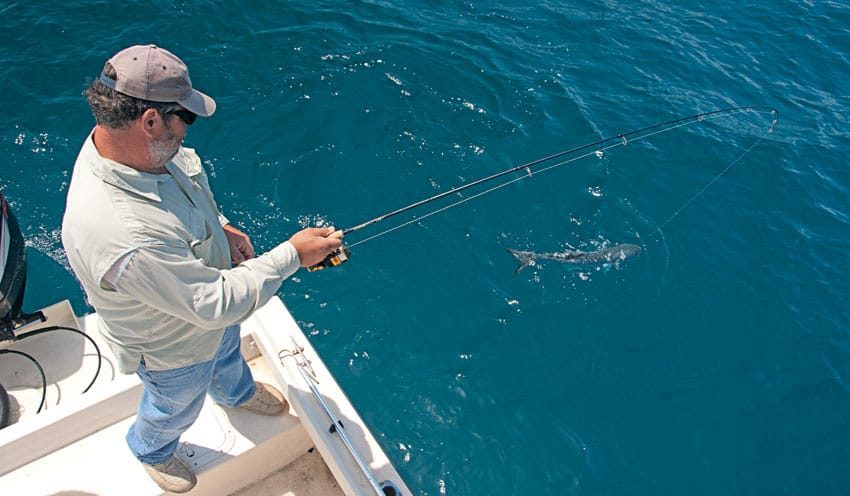
Perfect for Light Tackle
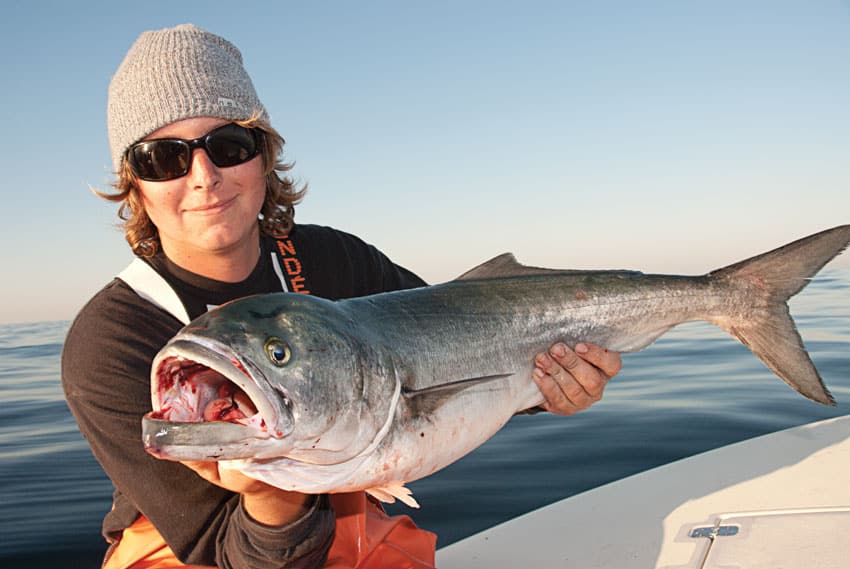
Follow the Bait
